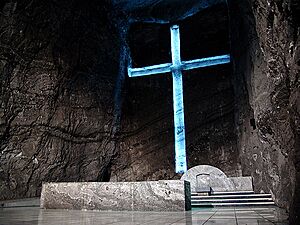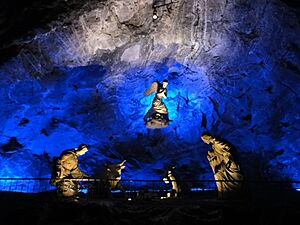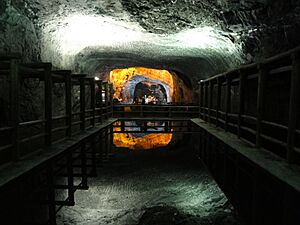Salt Cathedral of Zipaquirá facts for kids
Quick facts for kids Salt Cathedral of Zipaquirá |
|
|---|---|
|
Catedral de Sal
|
|

La Creación del Hombre, sculpture by Carlos Enrique Rodríguez
(Based in The Creation of Adam by Michelangelo), Central Barrel vault |
|
| Religion | |
| Affiliation | Roman Catholic |
| District | Diocese of Zipaquirá |
| Location | |
| Location | Zipaquirá, Colombia |
| Architecture | |
| Architectural type | Church |
| Completed | 1950 |
The Salt Cathedral of Zipaquirá (which means Catedral de Sal in Spanish) is a unique underground Roman Catholic church. It is built inside the tunnels of an old salt mine. This amazing church is about 200 meters (656 feet) underground. It is located near the city of Zipaquirá in Colombia. Many people visit it as a tourist destination and a special place for pilgrimage.
The church has three main parts deep inside, which represent the birth, life, and death of Jesus. The statues, decorations, and building details are all carved by hand from the salt rock itself. You can also see some sculptures made of marble. People think this cathedral is one of the most impressive buildings in Colombia. It is called a "Jewel of Modern Architecture." It is very important for Colombia's culture, mining history, and religious heritage.
Even though it's called a cathedral, it doesn't have a bishop. So, it's not an official cathedral in the Catholic Church. But it is a real church that holds services. On Sundays, as many as 3,000 visitors come to see it.
Contents
How the Salt Formed
The salt deposits in Zipaquirá were created about 250 million years ago. Imagine a time when dinosaurs were just starting to appear! Later, when the Andes mountains were forming, these salt layers were pushed up above sea level. This is how the salt mountain came to be.
Where to Find the Salt Cathedral
The Salt Cathedral is in Zipaquirá, a city in the Cundinamarca Department. It's about 49 kilometers (30 miles) north of Bogota, the capital of Colombia. The city is high up, at about 2,652 meters (8,700 feet) above sea level. You can get there from Bogotá by car on highway 45A or by taking the Tren Turistico De La Sabana (Savanna tourist train). Zipaquirá is also known for being close to El Abra, one of the oldest places where humans lived in the Americas.
History of the Salt Cathedral
Salt has been mined in this area for a very long time. The Muisca people, who lived here before Europeans arrived, started mining salt around 500 years before Jesus was born. Salt was a very important part of their economy.
In 1801, a famous explorer named Alexander von Humboldt visited Zipaquirá. He wrote about the traditional salt mining. He said these salt deposits were bigger than other major salt mines in places like Spain and Poland. He also suggested better ways to mine the salt.
The First Salt Cathedral

Miners started carving a small prayer place in the salt tunnels around 1932. They prayed there every day for safety before they began working. Then, in 1950, they started building a much bigger church. This first Salt Cathedral opened on August 15, 1954. It was dedicated to Our Lady of the Rosary, who is the special protector of miners.
This old church had three main sections and a huge cross. Some of its tunnels were even carved by the ancient Muisca people. However, because it was inside an active mine, there were worries about its safety. So, in September 1992, the authorities had to close it. Building this first church cost a lot of money, over 285 million U.S. dollars.
The old church was 120 meters (394 feet) long and covered an area of 5,500 square meters (59,200 square feet). It was 22 meters (72 feet) high and had six large columns. It could hold up to 8,000 people! The main section had a giant cross that was lit from below, making a big cross-shaped shadow on the ceiling.
The New Salt Cathedral

After the old cathedral closed, a competition was held to design a new one. The winning design was by Roswell Garavito Pearl. His plan included new ways to enter the church and a dome.
Construction on the new cathedral began in 1991. It was built 200 feet (61 meters) below the old one. This new cathedral opened on December 16, 1995. Its many hallways and prayer areas were made by carefully adding to the caves left by earlier mining.
Here are some of the main parts of the new cathedral:
- The Stations of the Cross: As you enter, there are 14 small chapels. These show the story of Jesus' last journey. Each chapel has a cross and places to kneel, all carved into the salt.
- The Dome: This is at the end of the main entrance ramp. From here, visitors go down to other areas like the cross chambers and a maze-like entrance hall.
- The Three Naves: These are the three main sections of the church. They are connected by a crack, which represents the birth and death of Christ. You can see copies of famous sculptures like Creation of Adam and Pietá here. Four big round columns represent the Four Evangelists.
The cathedral even has its own electrical generator. It also has a special entrance for vehicles in case of emergencies.
Salt Park
The Salt Cathedral is part of a bigger area called Parque de la Sal (Salt Park). This park also has a museum about mining, mineralogy (the study of minerals), geology (the study of Earth), and natural resources. The Salt Park covers a large area of about 32 hectares (79 acres). Visitors can see art, learn about how mining works, and explore exhibits about geology. There are also educational displays about mining in a way that is good for the environment and helps with sustainable development.
Some of the main places in the park are:
- The Sacred Axis: This is a square with a cross carved from salt. It is 4.2 meters (13.8 feet) tall.
- The Salt Dome
- The Mine
- The Brine Museum: Here, visitors learn how salt is taken out of the salt rock. You can also see exhibits about the geological studies, engineering, and architecture that went into creating the cathedral.
- The Reservoir
- The Forests
- The Salt Auditorium
Other Salt Mines to Explore
- Nemocón, a nearby salt mine
- Bochnia Salt Mine, in Poland
- Wieliczka Salt Mine, also in Poland
- Khewra Salt Mine, in Pakistan
See also
 In Spanish: Catedral de Sal para niños
In Spanish: Catedral de Sal para niños



